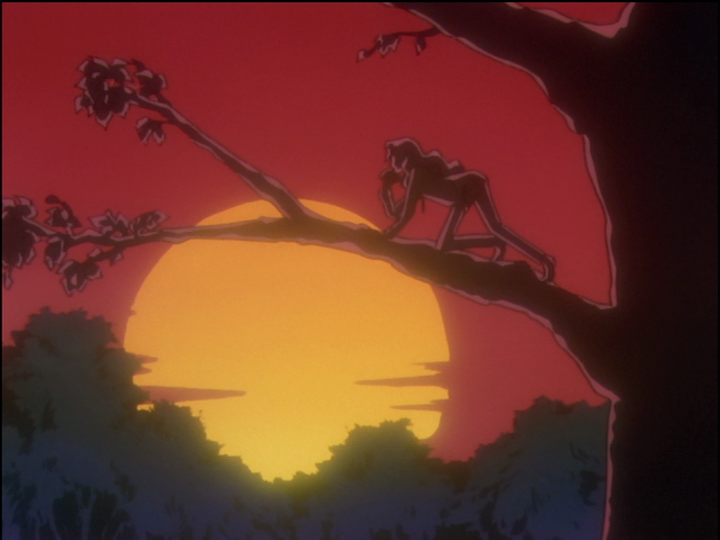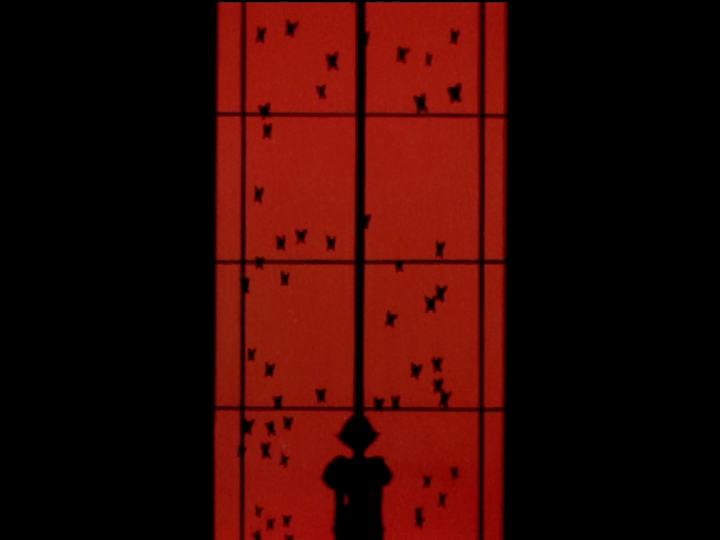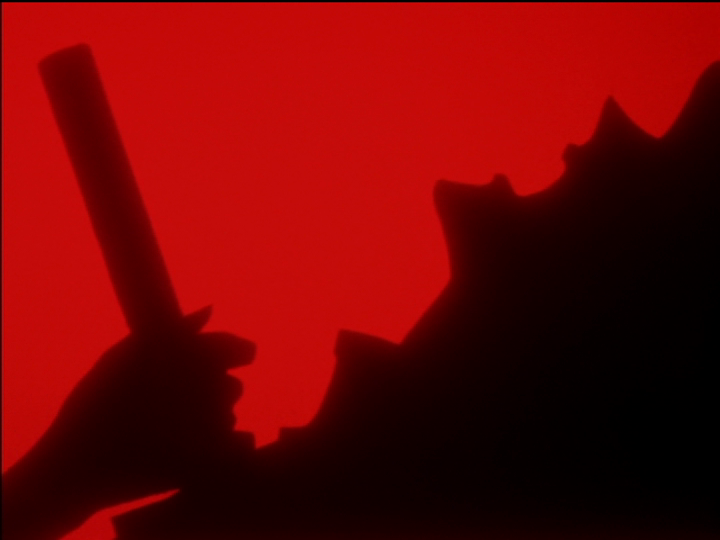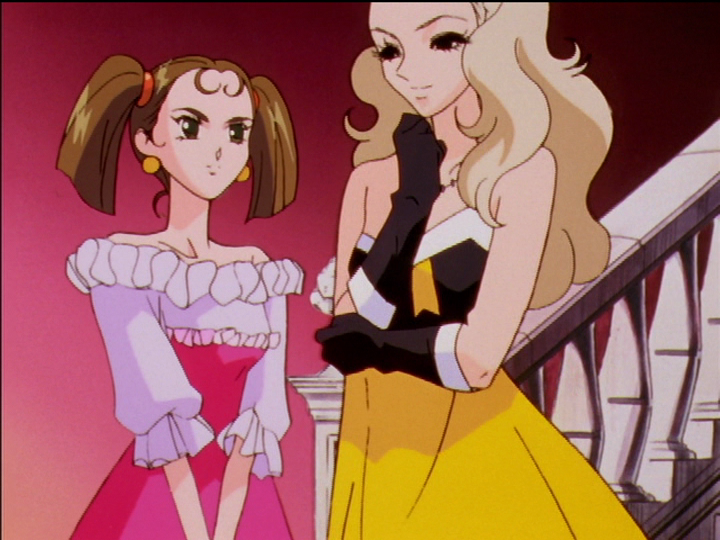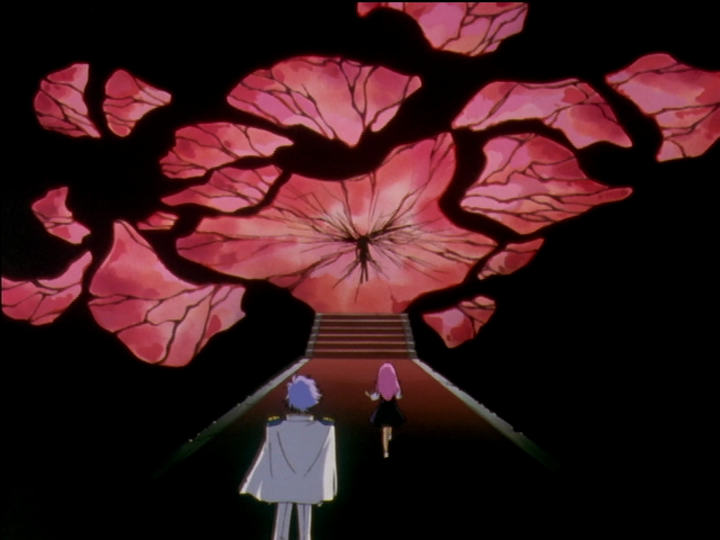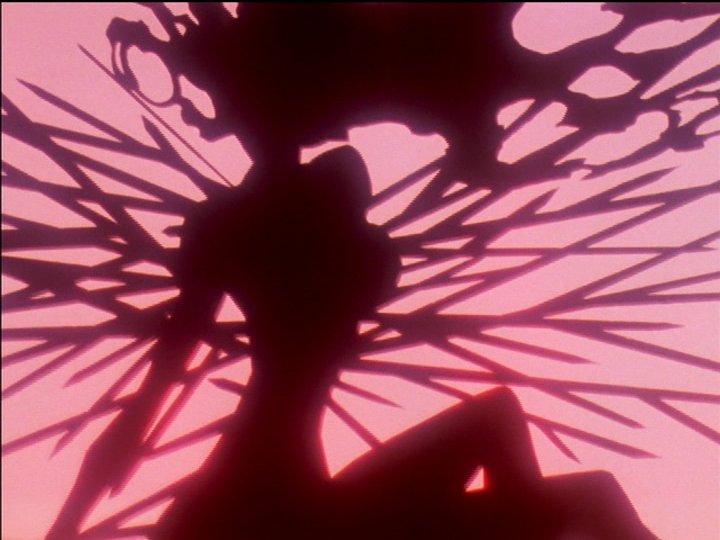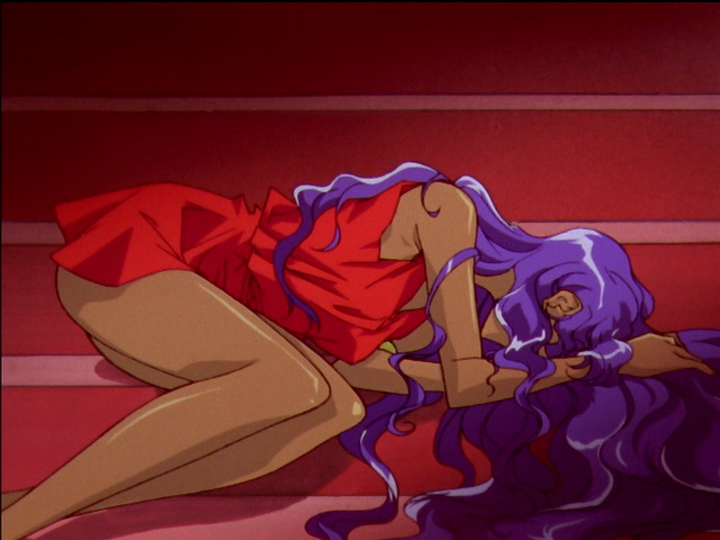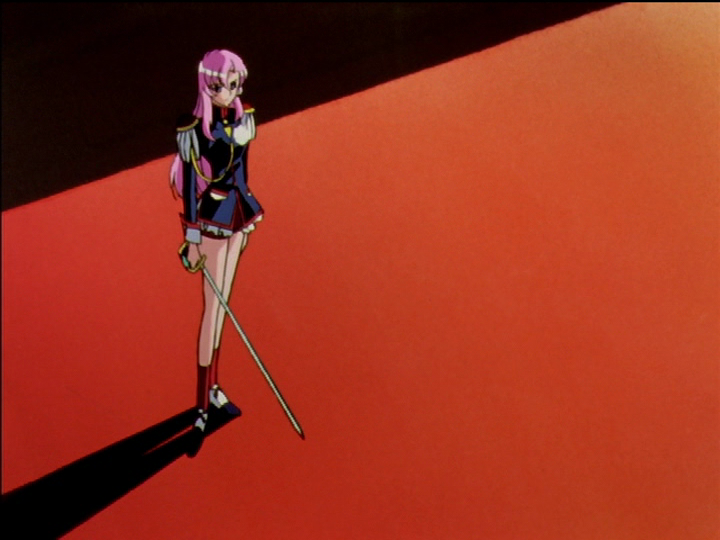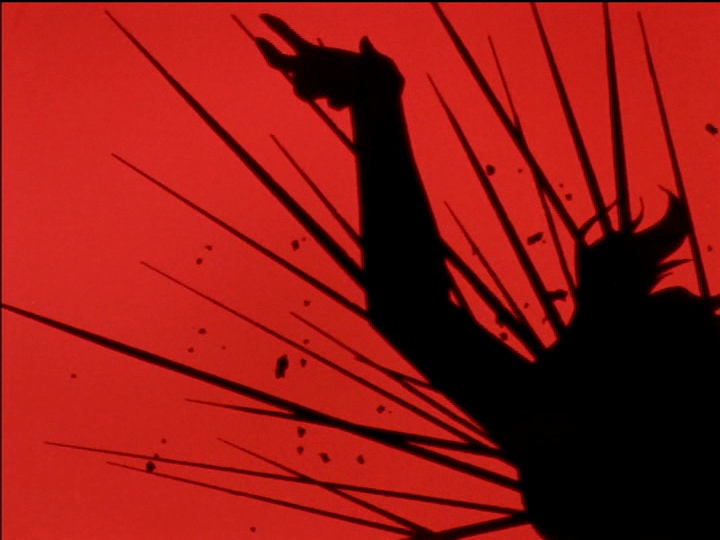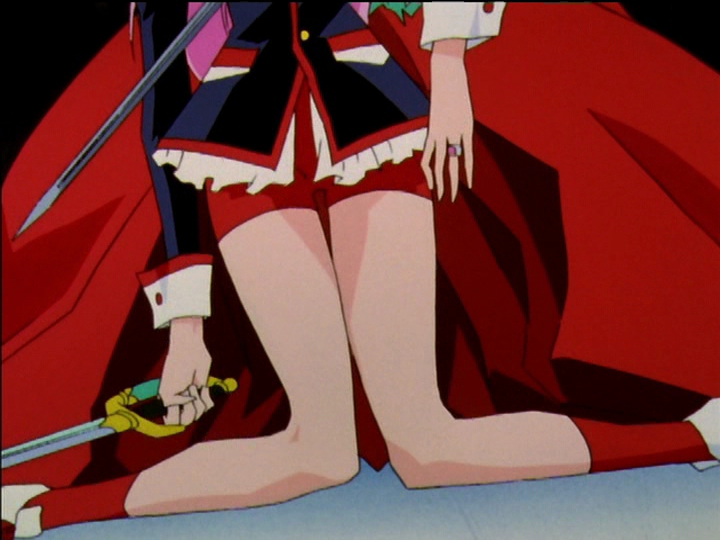Utena - red catalog
Catalog of images with red backgrounds. They mostly mark dramatic and/or violent events, and significant moments. Many are connected with duels. The basic meaning of red in Utena is sin, especially the “sins” of sex and knowledge embodied in Eve’s apple. Another popular sin is violence, where the red can be blood.
The red backgrounds are most often abstract, but sometimes they represent concrete physical objects.
I don’t include the shadow plays, which are red for knowledge of good and evil, and for firelight.
Bright red backgrounds stand out, but all the background colors matter. Abstract backgrounds are common, sometimes in a single color, sometimes complex. A very common background is blue sky with white clouds (made of water) for the obscuring illusion of the prince. The partly cloudy blue sky is prominent in duels.
The eyecatch image which breaks each episode in half. It’s where a commercial ran when the show was on TV. It’s not a dramatic or significant moment. Personally, I think it’s red because ads do violence to the story, but there may be more reasons. Other meta-elements of the story, like title cards, are associated with red. It’s fair to say that Utena as a whole is a story about sin, especially the sin of knowledge. The most knowledgable characters are the most sinful and are associated with red: Akio (red shirt), Anthy (red princess dress), Touga (red hair). The eyecatch is red beause the story is red. It’s about knowledge of the truth, which is shunned as a sin.
Chu-Chu and Saionji have been body-swapped (or personality-swapped if you like; it’s the same thing). The red sunset silhouettes Chu-Chu on a tree limb, dropping an eaten banana—Chu-Chu is a sloppy eater and drops crumbs if nothing else. Slipping on a banana peel is a running gag, for when Anthy’s manipulation of Nanami is to make Nanami look silly. Akio’s control over others is silly even when it is deadly serious. The banana as a symbol is both male and female.
Possibly the banana calls forward to Saionji and Touga’s later relationship.
Saionji attacks Utena and Touga pretends to be a prince and defends her. It is red for violence and deception.
From the episode 11 duel. Left, Touga thinks about how his plot requires the Power of Dios to manifest. Center, Touga has won and Anthy says that she is happy as the Rose Bride. Right, Utena has faded to a shadow and the background has become Touga’s red hair. Touga explains the Rose Bride role.
Utena stands as if caught between giant images of Touga—which she is. It is the red of deception, and suggests power.
Our introduction to Akio begins with Akio considering the episode 12 duel against Touga. The red background marks it as important, and all earlier red backgrounds included Touga. Later we learn that Touga is an Akio wannabe. So far, the red backgrounds have indicated violence, deception, and power, all characteristics of Akio.
Most fundamentally, red is the color of Eve’s apple. It ties first of all to sex and knowledge of good and evil, central to Akio’s character.
Kanae, still standing in the confession elevator, is stabbed with the black rose, which seems to turn her black for the moment. The purple outline on the spinning black rose emphasizes that Mamiya and Mikage are taking a corrupt action. Anthy (who plays Mamiya) and Akio are associated with red by their clothing and purple by their hair, and red backgrounds are associated with Akio via Touga. They are hints that ultimately Akio is behind the black rose.
The confession elevator interior has changed colors for the event.
The butterflies in the background as Kozue pulls Miki’s sword call back to the spotted white butterflies introduced in episode 5, pests which were marked as bad by a sound effect.
Black Rose sword pulls are often on red. Juri’s sword pull in episode 17 is on an orange background.
Nanami is turning into a cow. It’s the red of the red sweater that Anthy knitted to top off her hoax on Nanami. Utena removing Nanami’s cowbell is depicted as if it were a duel, and the red fits with that. Most of the scene is on red. The red gradient contrasts with the solid red of other red backgrounds—since the use of red is extended, it makes the scene easier to read and more visually interesting.
A gradient runs red to white. Most red gradients go to black or to darker red. The cow’s gradient is opposite. The prince’s white should point to Utena removing the cowbell, which foreshadows her ultimate victory.
Tatsuya’s pursuit of Wakaba is associated with a vivid red sunset sky, which is at its most intense in the scene where Wakaba rejects him. It is orange-ish and shades into orange at the bottom for one-sided love. It seems to be the sunset of endings.
Wakaba’s S-shaped hair from this angle forms a question mark. It might mean something.
When Wakaba runs home to meet Saionji in her room, one corner of the frame is shaded red. It’s a red overlay, not a red background. The rest of the image has a paler color overlay. When Wakaba arrives, her room is purple. Saionji is silhouetted against a yellow background, which fades into a sunset sky seen through a window, orange for one-sided love. The situation is cued as wrong in various ways.
Left, Wakaba rushes toward Saionji to pull his sword. The black corner is inverted sunlight, Dios turned to Akio: A moment earlier, the sun shining through the window lit the wall in that corner of the frame. Right, the sword being pulled. The red is brighter. Saionji’s profile echoes the diagonal of the black corner. Wakaba is the only one to pull out the sword of her Black Rose victim with her hands; the others float free untouched.
I don’t know what the connection is with the red overlay above, but surely there is one. It’s some kind of reversal.
Left, Nanami sends Keiko away from the party to keep her away from Touga. Nanami is on the dark side of the shadow line, because she is being cruel to Keiko. Right, Keiko has taken Touga’s sword. See the comparison of girls embracing swords.
Both scenes are inside the Kiryuu mansion, which is depicted as red in this episode. Some other scenes in the episode have less prominent red backgrounds. The episode has no abstract red backgrounds, only concrete ones.
Miki is in the frame, but Nanami is complaining to Juri that she hasn’t identified the Black Rose yet. The background looks abstract, but it’s not: The red is the wall of the Student Council elevator. Compare Kanae in the confession elevator, which turned red when she was stabbed by the black rose.
This image and the two immediately above are laid out similarly. They have one person in the background facing the camera, and one in the foreground facing left. Nanami thinks she can keep Keiko away from Touga; Touga is passive and fell under Keiko’s control; Miki is being ignored. There may be more to it.
Mikage burns down his building. The related scenes are red for the fire of destruction, the blood of violence, and the sin of murder. The fire throws yellow sparks (though in the left image the sparks are white), no doubt for Mikage’s jealousy over Akio seducing Tokiko—one of Mikage’s motivations for starting the blaze.
From Nanami’s Egg. When Touga tells her that a girl who lays eggs betrays her family, Nanami turns blue and the window behind her turns red and fills with flying bats. It goes with the image with Kozue above in episode 15: By taking her twin Miki’s sword, Kozue was betraying her family. In Nanami’s case, Touga is in on Anthy’s hoax (or possibly he figured out Nanami’s delusion on his own) and he tells her a lie. Nanami turns blue for illusion because she accepts the lie. Scenes that Nanami imagines are frequently blue in the episode.
Bats do not lay eggs.
Still in Nanami’s Egg, Nanami and Touga sit at opposite ends of a long table. In the morning, they talked in a white room with a long table and Nanami saw the bats. Here they eat an evening meal in a red room with a long table. Either the mansion has separate breakfast and dining rooms, or the room is an unstable location. In any case, the room is red because Nanami has abandoned her egg in the forest.
Her false beliefs put her in an impossible situation. To admit she had laid an egg would be to betray her family, so she abandons the egg, betraying her family. She believes she is a monstrous kitten killer and egg abandoner (and the egg is her child).
Juri is thoughtful and insightful, unlike Utena, but her insight is not helping. Left, Juri ponders her inability to express her feelings about Ruka (not about Shiori; she implies that she’s thinking of someone who loves her, and does not believe that Shiori does). The red is abstract and seems to blame Akio’s system of control for Juri’s inability to express herself. Right, the ocean stretches away, orange and red with sunset. As in the Second Seduction, the ocean seems to stand for eternity—in Juri’s case, an eternity of one-sided love.
Juri imagines her heart whispering feelings to her. It connects with the title of the episode, “Whispers in the dark” in the Nozomi translation. Juri’s heart is in darkness.
Ruka seducing Shiori is all in red. There are more images of it than just these two. Left, Shiori stands with her hand on Ruka’s locker as if on Ruka’s chest. Every locker is red, including Juri’s just to the left. How much did Ruka know before arriving at the fencing club? Did he count on his appeal to lure Shiori to him (his watching crowd was almost all girls), or was it a happenstance that he took advantage of? He could have planned ahead, but he’s capable and could have made a plan on the fly. I don’t see evidence. Right, Shiori holds Ruka’s sword, expecting to be blamed. She submissively cedes initiative and power to Ruka.
Juri changes her mind and goes to tell Shiori she should break up with Ruka. The background is red again, and Juri is on the dark side of the shadow line even though she is trying to do good. Do or don’t, think or act, Juri seemingly cannot escape her trap.
The image must be from Shiori’s point of view. She believes Juri is trying to sabotage her.
Touga introduces Akio’s car to Shiori. The car stands in the basin of the fountain of illusions; the water just now parted to reveal it. Akio and Ruka are in the car. Touga’s shirt is open, predicting what will happen. The foreground and background have turned red. Shiori looks bewildered. The camera has moved in close and low to the ground, and behind Touga the base of the fountain’s central sculpture looks huge.
The picture on the right shows the scene before the car arrived: A fountain with a circular basin and a central sculpture that pours water at meaningful times. The angel pours water from Ganymede’s jug—see Ganymede for the background.
Juri challenges Utena to a duel. It is sunset, and the inside of the building is red. Utena respects Juri, and has stepped forward to express her objection—you have fallen into the duels too? Of course Utena says it more bluntly.
Compare to the classroom image above. Juri faces away from Utena: She is not pleased by the duel either, but has yielded to Ruka’s coercion. Juri is in a darker area, but is light against the white light of the window. Utena stands in a lighter area, but behind her is a dark wall; she does not know a thing about why Juri is behaving so. I think both are beyond the shadow line. Juri’s feet are in the dark because she feels forced into it, and Utena’s head is in the dark because she doesn’t understand.
It’s sunset again. The school corridor is red as the teachers try to scold Utena into wearing the girls’ uniform. It remains red as Akio leads Utena away from them—the whole scene is about Akio’s pressure on Utena to violate her ideals and ultimately enter into a sexual relationship with him. The scene is flanked by silhouettes against orange backgrounds for the one-sided love Akio is working to instill in Utena. The matching silhouettes before and after say that the teachers and Akio are working to the same end, even though Akio pretends to act against them.
It’s sunset yet again. Akio is driving Utena home from the clinic after her foot injury, and the ocean is red. The trees are yellowish, and there is a yellow glow from the setting sun, that is, from Dios. The trees are plants and associated with Anthy, so I guess the yellow represents Anthy’s jealousy. Then the endless red ocean represents the eternity of lies and other sins that Akio is luring Utena into. Or we could say that Utena’s purity and innocence are coming to an end with the ending day. The imagery repeats at the start of the Routine Date in episode 37, so it bookends the early and late steps of Akio’s corruption plot, from tempting Utena to exploiting her corruption.
When they arrive back at the tower, there’s a shot of the tower with a purple-red ocean behind it, emphasizing corruption over sin. At the Routine Date, the accompanying shot of the tower has a deep blue ocean. It may be for Akio’s illusion that Utena is now corrupted enough.
Little Anthy is suspended by the Swords of Hatred, as in the final showdown. Anthy’s parallel with the Little Mermaid implies that she always feels the Swords piercing her. The background is a disintegrating rose. It is Anthy’s red rose, and it aligns with Utena’s diseased pink rose in the final showdown. And it is Anthy’s coffin, that Utena reaches into after opening the Rose Gate. And it is a placenta; Anthy is in the womb, and is not born until she leaves the Academy. I won’t be surprised if there’s more.
Anthy is the most red character, because she offered the apple to Dios. It seems to me that all the meanings of red attach to Anthy; others get only some of the meanings.
Utena sits with Anthy on the hillside facing the dueling arena, and shows off the earrings to Chu-Chu. She has a sudden vision of Anthy’s hair blown in the wind, and then of swords piercing her. The background is more pink than red; Utena brought this.
Past events are replaying for Anthy. The wind is the prince’s power. The first time Anthy was affected by the prince’s power, Dios betrayed her and became Akio, and she met the Swords of Hatred. Now Anthy has been affected by the power of prince Utena, and Utena is betraying Anthy and going with Akio. Anthy feels the pain of the Swords at all times, but especially now. The swords branch like a plant.
Where does the vision come from? The image at right attributes it to the ring—to Dios, or equivalently to Utena’s power of miracles. It’s an early step in her miraculous victory. Alternately, it might mean only that what she forgot is from the prince story (but we already knew that).
Utena has a sleeping vision of little Anthy pierced by the Swords of Hatred, and wakes up. It is a memory, not perfectly recalled. The S-shaped bed has changed: Utena’s side is edged with white for the prince as usual, but Anthy’s side has a purple edge for corruption. Utena gets up and looks for Anthy, and finds her with Akio. The image repeats in the final showdown when Akio tells Utena that Anthy will be the Rose Bride forever.
I thought Akio arranged the meeting, but the vision of the previous episode is marked as a miracle, and Akio would not want to remind Utena of little Anthy, therefore he did not send the vision. This vision must be a miracle too. Utena’s power of miracles is telling her a truth that troubles her deeply but moves her toward her victory.
Anthy wears the too-small red dress of little Anthy from the prince story of episode 34, and lies in an awkward pose on stairs, her face turned down. But hey, it’s fine, Akio tells Utena not to be bothered by it. They are the stairs Akio walked down to play prince from a position above Utena. Anthy is pretty far away. Utena is isolated with Akio. Akio’s entrance path to the dueling arena, his room which is equated with the arena, and the exit to the Rose Gate, are all red.
In the origin myth, little Anthy caused Dios to turn into Akio and met the Swords of Hatred, two unexpected losses caused by her attempt to save Dios’s life. In the final showdown, Anthy attempts to take Utena’s life and intentionally attracts the Swords of Hatred. It’s opposite, but Akio dresses Anthy to imply that it is the same. Akio believes (I think it’s a belief, not an intentional lie) that Anthy chose to sacrifice herself then, and does now.
In the final showdown, Akio’s second challenge to Utena takes place in his tower room. Parts of it have the red carpet as background. Here Akio is telling Utena that if he is bad, then she is the same. Follow the link for analysis.
In the leadup to the duel of the final showdown, we’re shown the duel’s French name, révolution. It calls back to the duel names in episode 13. At first we get fragments of the word, on different colors, then the entire word on purple. I picked out the two fragments on red.
All of Utena’s main colors appear behind the fragmentary words. I suppose it means that every Student Council member participates in the duel to some extent; see final showdown - the first interlude with the Student Council. The fragmented word goes with the fragmented recitation of the egg of the world speech. The final name is purple because Akio’s plot corrupts the revolution into its opposite: He is the monarch and seeks more power for himself.
Red for violence and blood. Anthy’s dress behind Utena visually represents streaming blood. See Anthy’s backstab - the literal depiction and blood catalog - Utena fallen.
The image emphasizes the red in Utena’s costume. Her red shorts are front and center; that is where she allowed Akio’s metaphorical sword to pierce her, which in turn brought about the conditions for the physical sword to pierce her. Her red socks are prominent too.
Utena is in the process of collapsing. She does not have the strength to stand. Even her free hand hangs without strength. But she still grasps the sword, though perhaps not tightly. Anthy has to loosen her fingers to take it.
Akio broke Utena’s sword on the Rose Gate. He holds the stub in front of the red carpet of the walkway, looking at it for a moment before tossing it away. There is a blue glint of illusion on the bit of remaining blade. I think it means that Utena’s power of miracles is not broken, but continues to operate.
The Swords of Hatred converge on Anthy in the air and stab her. It comes with a sequence of red-background images, the Swords piercing her hands, then her feet, then this overall image. She is crying out in pain, as when she first met the Swords (episode 34) and as Black Rose victims do (Juri in episode 17) when their swords are taken.
It goes with the image of Nanami turning into a cow; Anthy’s pose and movement match up. Nanami faces right, toward truth, for her self-destructive action, while Anthy faces left for illusion; she accepts Akio’s patriarchal belief that self-sacrifice is her role (see sacrifice - sacrificing others). I don’t know about Nanami, though. Anthy, like Nanami and like Utena, is the rabbit in the moon.

